Edible City Solutions—One Step Further to Foster Social Resilience through Enhanced Socio-Cultural Ecosystem Services in Cities
Abstract
1. Introduction
2. Materials and Methods
2.1. Conceptual Framework of Edible City Solutions
2.2. Literature Review on ECS Benefits for Urban Regeneration
2.3. Case Studies for Status Quo Analysis of ECS and Strategy Development
3. Results
3.1. Scientific Evidence on ECS Benefits for Urban Regeneration
3.2. Status Quo of ECS in Case Study Cities and SWOT Analysis
4. Discussion
4.1. Long-Term and Cross-Sectoral Mainstreaming of ECS
4.2. Co-planning, Co-Design, and Co-Implementation
4.3. Avoiding Green Gentrification
4.4. Green Jobs Created by ECS
5. Conclusions
Author Contributions
Funding
Acknowledgments
Conflicts of Interest
References
- Haaland, C.; Konijnendijk Van den Bosch, C.K. Challenges and strategies for urban green-space planning in cities undergoing densification: A review. Urban For. Urban Green. 2015, 14, 760–771. [Google Scholar] [CrossRef]
- Sarkar, C.; Webster, C. Urban environments and human health: Current trends and future directions. Curr. Opin. Environ. Sustain. 2017, 25, 33–44. [Google Scholar] [CrossRef]
- Jennings, V.; Johnson Gaither, C.; Schulterbrand Gregg, R. Promoting Environmental Justice Through Urban Green Space Access: A Synopsis. Eviron. Justice 2012, 5, 1–7. [Google Scholar] [CrossRef]
- Hayhoe, K.; Robson, M.; Rogula, J.; Auffhammer, M.; Miller, N.; VanDorn, J.; Wuebbles, D. An integrated framework for quantifying and valuing climate change impacts on urban energy and infrastructure: A Chicago case study. J. Great. Lakes Res. 2010, 36, 94–105. [Google Scholar] [CrossRef]
- Ferrer, A.L.C.; Thomé, A.M.T.; Scarvada, A.J. Sustainable urban infrastructure: A review. Resour. Conserv. Recyl. 2018, 128, 360–372. [Google Scholar] [CrossRef]
- Kabisch, N.; Frantzeskaki, N.; Pauleit, S.; Naumann, S.; Davis, M.K.; Artmann, M.; Haase, D.; Knapp, S.; Korn, H.; Stadler, J.; et al. Nature-based solutions to climate change mitigation and adaptation in urban areas: Perspectives on indicators, knowledge gaps, barriers, and opportunities for action. Ecol. Soc. 2016, 21, 39. [Google Scholar] [CrossRef]
- Haase, D.; Kabisch, S.; Haase, A.; Andersson, E.; Banzhaf, E.; Baró, F.; Brenck, M.; Fischer, L.K.; Frantzeskaki, N.; Kabisch, N.; et al. Greening cities—To be socially inclusive? About the alleged paradox of society and ecology in cities. Habitat Int. 2017, 64, 41–48. [Google Scholar] [CrossRef]
- Nesshöver, C. The science, policy and practice of nature-based solutions: An interdisciplinary perspective. Sci. Total. Environ. 2017, 579, 1215–1227. [Google Scholar] [CrossRef]
- EU Commission, Nature Based Solutions. Available online: https://ec.europa.eu/research/environment/index.cfm?pg=nbs (accessed on 3 April 2018).
- Wiskerke, J.S.C.; Viljoen, A. Sustainable Food Planning: Evolving Theory and Practice; Wageningen Academic Publishers: Wageningen, The Netherlands, 2012. [Google Scholar]
- Eigenbrod, C.; Gruda, N. Urban vegetable for food security in cities. A review. Agron. Sustain. Dev. 2015, 35, 483–498. [Google Scholar] [CrossRef]
- Russo, A.; Escobedo, F.J.; Cirella, G.T.; Zerbe, S. Edible green infrastructure: An approach and review of provisioning ecosystem services and disservices in urban environments. Agric. Ecosyst. Environ. 2017, 242, 53–66. [Google Scholar] [CrossRef]
- Lafforgu, M.; Lenouvel, V. Closing the urban water loop: Lessons from Singapur and Windhoek. Environ. Sci. Water Res. 2015, 1, 622–631. [Google Scholar] [CrossRef]
- Ghisellini, P.; Cialani, C.; Ulgiati, S. A review on circular economy: The expected transition to a balanced interplay of environmental and economic systems. J. Clean. Prod. 2016, 114, 11–32. [Google Scholar] [CrossRef]
- Rhodes, C.J. The imperative for regenerative agriculture. Sci. Prog. 2017, 100, 80–129. [Google Scholar] [CrossRef] [PubMed]
- Naturkapital Deutschland—TEEB DE (Ed.) Ingo Kowarik, Robert Bartz und Miriam Brenck. Available online: https://www.ufz.de/export/data/global/190508_TEEB_DE_Stadtbericht_Langfassung.pdf (accessed on 15 April 2018.).
- Bühler, D.; Junge, R. Global Trends and Current Status of Commercial Urban Rooftop Farming. Sustainability 2016, 8, 1108. [Google Scholar] [CrossRef]
- Besthorn, F.H. Vertical Farming: Social Work and Sustainable Urban Agriculture in an Age of Global Food Crises. Aust. Soc. Work 2012, 66, 187–203. [Google Scholar] [CrossRef]
- Roberts, P. Urban Regeneration; Sage Ltd.: London, UK, 2017; pp. 9–44. [Google Scholar]
- Ackerman, K.; Conard, M.; Culligan, P.; Plunz, R.; Sutto, M.P.; Whittinghill, L. Sustainable Food Systems for Future Cities: The Potential of Urban Agriculture. Econ. Soc. Rev. 2014, 45, 189–206. [Google Scholar]
- Helms, M.; Nixon, J. Exploring SWOT analysis—Where are we now? A review of academic research from the last decade. J. Strategy Manag. 2010, 3, 215–251. [Google Scholar] [CrossRef]
- Orsini, F.; Kahane, R.; Nono-Womdim, R.; Gianquinto, G. Urban agriculture in the developing world: A review. Agron. Sustain. Dev. 2013, 33, 695–720. [Google Scholar] [CrossRef]
- Hamilton, A.J.; Burry, K.; Mok, H.F.; Barker, F.; Grove, J.R.; Williamson, V.G. Give peas a chance? Urban agriculture in developing countries. A review. Agron. Sustain. Dev. 2014, 34, 45–73. [Google Scholar] [CrossRef]
- Palma, I.P.; Toral, J.N.; Vázquez, M.R.P.; Fuentes, N.F.; Hernández, F.G. Historical changes in the process of agricultural development in Cuba. J. Clean. Prod. 2015, 1, 77–84. [Google Scholar] [CrossRef]
- Riches, G. First World Hunger: Food Security and Welfare Politics; Macmillan: New York, NY, USA; St Martins: London, UK, 1997. [Google Scholar]
- Middleton, G.; Mehta, K.; McNaughton, D.; Booth, S. The experiences and perceptions of food banks amongst users in high-income countries: An international scoping review. Apetite 2018, 120, 698–708. [Google Scholar] [CrossRef] [PubMed]
- Loopstra, R. Rising food bank use in the UK: Sign of a new public health emergency? Nutr. Bull. 2018. [Google Scholar] [CrossRef]
- Tei, F.; Benincasa, P.; Farneselli, M.; Caprai, M. Allotment Gardens for Senior Citizens in Italy: Current status and technical proposals. Acta Hortic. 2010, 881, 91–96. [Google Scholar] [CrossRef]
- Mok, H.F.; Williamson, V.G.; Grove, J.R.; Burry, K.; Barker, S.F.; Hamilton, A.J. Strawberry fields forever? Urban agriculture in developed countries: A review. Agron. Sustain. Dev. 2014, 34, 21–43. [Google Scholar] [CrossRef]
- Anguelovski, I. From Environmental Trauma to Safe Haven: Place Attachment and Place Remaking in Three Marginalized Neighborhoods of Barcelona, Boston, and Havana. City Commun. 2013, 12, 211–237. [Google Scholar] [CrossRef]
- Birky, J.; Strom, E. Urban perennials: How diversification has created a sustainable community garden movement in the United States. Urban Geogr. 2013, 34, 1193–1216. [Google Scholar] [CrossRef]
- Ergas, C.; Holt, W.G. Barriers to sustainability: Gendered divisions of labor in cuban urban agriculture from sustainable to resilient cities: Global concerns and urban efforts. Res. Urban Sociol. 2014, 14, 239–263. [Google Scholar]
- Agyeman, J.; Evans, T. Toward Just Sustainability in Urban Communities: Building Equity Rights with Sustainable Solutions. Ann. Am. Acad. Polit. Soc. Sci. 2003, 590, 35–53. [Google Scholar] [CrossRef]
- Fainstein, S. The Just City; Cornell University Press: Ithaca, NY, USA, 2010. [Google Scholar]
- Farges, G. Convergence on Sustainable Lifestyles? Mechanisms of Change and Resistance in a French Allotment. Sociol. Rural. 2015, 55, 1–21. [Google Scholar] [CrossRef]
- D’Acci, L. Monetary, Subjective and Quantitative Approaches to Assess Urban Quality of Life and Pleasantness in Cities (Hedonic Price, Willingness-to-Pay, Positional Value, Life Satisfaction, Isobenefit Lines). Soc. Indic. Res. 2014, 115, 531–559. [Google Scholar] [CrossRef]
- Krekel, C.; Kolbe, J.; Wustemann, H. The greener, the happier? The effects of urban green and abandoned areas on residential well-being. Ecol. Econ. 2016, 121, 117–121. [Google Scholar] [CrossRef]
- Leake, J.; Adam-Bradford, A.; Rigby, J.E. Health benefits of ‘grow your own’ food in urban areas: Implications for contaminated land risk assessment and risk management? Environ. Health 2009, 8, S6. [Google Scholar] [CrossRef] [PubMed]
- Cameron, R.W.F.; Blanusa, T.; Taylor, J.E.; Salisbury, A.; Halstead, A.J.; Henricot, B.; Thompson, K. The domestic garden—its contribution to urban green infrastructure. Urban For. Urban Green 2012, 11, 129–137. [Google Scholar] [CrossRef]
- Hartig, T.; Mitchell, R.; de Vries, S.; Frumkin, H. Nature and Health. Annu. Rev. Public Health 2014, 35, 21.1–21.22. [Google Scholar] [CrossRef] [PubMed]
- Roe, J.; Aspinall, P.A.; Ward Thomsen, C. Coping with Stress in Deprived Urban Neighborhoods: What Is the Role of Green Space According to Life Stage? Front. Psychol. 2017. [CrossRef] [PubMed]
- Apparicio, P.; Séguin, A.M.; Dubé, J. Spatial distribution of vegetation in and around city blocks on the Island of Montreal: A double environmental inequity? Appl. Geogr. 2016, 76, 128–136. [Google Scholar] [CrossRef]
- Wong, R.; Gable, L.; Rivera-Núñez, Z. Perceived Benefits of Participation and Risks of Soil Contamination in St. Louis UrbanCommunity Gardens. J. Commun. Health 2018, 43, 604–610. [Google Scholar] [CrossRef]
- Galluzzi, G.; Eyzaguirre, P.; Negri, V. Home gardens: Neglected hotspots of agro-biodiversity and cultural diversity. Biodivers. Conserv. 2010, 19, 3635–3654. [Google Scholar] [CrossRef]
- Taylor, J.R.; Lovell, S.T. Urban home food gardens in the Global North: Research traditions and future directions. Agric. Hum. Values 2015, 30, 22–32. [Google Scholar] [CrossRef]
- Guitart, D.; Pickering, C.; Byrne, J. Past results and future directions in urban community gardens research. Urban For. Urban Green. 2012, 11, 364–373. [Google Scholar] [CrossRef]
- Camps-Calvet, M.; Langemeyer, J.; Calvet-Mir, L. Ecosystem services provided by the urban gardens in Barcelona, Spain: Insights for policy and planning. Environ. Sci. Policy 2016, 62, 14–23. [Google Scholar] [CrossRef]
- Lapina, L. ‘Cultivating Integration’? Migrant Space-making in Urban Gardens. J. Intercult. Stud. 2017, 38, 621–636. [Google Scholar] [CrossRef]
- Bendt, P.; Barthel, S.; Colding, J. Civic greening and environmental learning in public- access community gardens in Berlin. Landsc. Urban Plan. 2013, 109, 18–30. [Google Scholar] [CrossRef]
- Travaline, K.; Hunold, C. Urban agriculture and ecological citizenship in Philadelphia. Local Environ. 2010, 15, 581–590. [Google Scholar] [CrossRef]
- Brisman, A. Crime-Environment Relationships and Environmental Justice. Seattle J. Environ. Justice 2007, 6, 14. [Google Scholar]
- Wolch, J.R.; Byrne, J.; Newell, J. Urban green space, public health, and environmental justice: The challenge of making cities ‘just green enough’. Landsc. Urban Plan. 2014, 125, 234–244. [Google Scholar] [CrossRef]
- Horst, M.; McClintock, N.; Hoey, L. The Intersection of Planning, Urban Agriculture, and Food Justice A. Review of the Literature. J. Am. Plan. Assoc. 2017, 83, 277–295. [Google Scholar] [CrossRef]
- Blair, D. The child in the garden: An evaluative review of the benefits of school gardening. J. Environ. Educ. 2009, 40, 15–38. [Google Scholar] [CrossRef]
- Bucher, K. Opening garden gates: Teachers make meaning of school gardens in Havana and Philadelphia. Teach. Teach. Educ. 2017, 63, 12–21. [Google Scholar] [CrossRef]
- Ray, R.; Fisher, D.R.; Fisher-Maltese, C. School Gardens in the City Does Environmental Equity Help Close the Achievement Gap? Du Bois Rev. Soc. Sci. Res. Race 2016, 13, 379–395. [Google Scholar] [CrossRef]
- Hellermann, M. Gardening on the Fringes: A Case Study at City Tech. Food Cult. Soc. 2017, 651–669. [Google Scholar] [CrossRef]
- Hand, K.L.; Freeman, C.; Seddon, P.J.; Recio, M.R.; Stein, A.; van Heezik, Y. The importance of urban gardens in supporting children’s biophilia. Proc. Natl. Acad. Sci. USA 2017, 114, 274–279. [Google Scholar] [CrossRef] [PubMed]
- Grewal, S.S.; Grewal, P.S. Can cities become self-reliant in food? Cities 2012, 29, 1–11. [Google Scholar] [CrossRef]
- Vasquez, A.; Sherwood, N.E.; Larson, N.; Story, M. Community-Supported Agriculture as a Dietary and Health Improvement Strategy: A Narrative Review. J. Acad. Nutr. Diet. 2017, 117, 83–94. [Google Scholar] [CrossRef] [PubMed]
- Rossi, J.J.; Woods, T.A.; Allen, J.E. Impacts of a Community Supported Agriculture (CSA) Voucher Program on Food Lifestyle Behaviors: Evidence from an Employer-Sponsored Pilot Program. Sustainability 2017, 9, 1543. [Google Scholar] [CrossRef]
- Säumel, I.; Kotsyuk, I.; Hölscher, M.; Lenkereit, C.; Weber, F.; Kowarik, I. How healthy is urban horticulture in high traffic areas? Trace metal concentration in vegetable crops from plantings within Inner city neighbourhoods in Berlin, Germany. Environ. Pollut. 2012, 165, 124–132. [Google Scholar] [CrossRef] [PubMed]
- Pothukuchi, K. Vacant land disposition for agriculture in Cleveland, Ohio: Is community development a mixed blessing? J. Urban Aff. 2018, 40, 657–678. [Google Scholar] [CrossRef]
- Meenar, M.; Morales, A.; Bonarek, L. Regulatory Practices of Urban Agriculture: A Connection to Planning and Policy. J. Am. Plan. Assoc. 2017, 83, 389–403. [Google Scholar] [CrossRef]
- Barriers to Advancing Sustainable Urban Water Management: A Typology. 2007. Available online: https://pdfs.semanticscholar.org/40c4/0c840b0e910395f37b7ec5e81ae1bb014885.pdf (accessed on 15 April 2018).
- Rogge, E.; Kerselaers, E.; Prove, C.A.F. Envisioning Opportunities for Agriculture in Peri-Urban Areas. Metrop. Rural. 2016, 23, 161–189. [Google Scholar]
- Gofen, A. Reconciling policy dissonance: Patterns of governmental response to policy noncompliance. Policy Sci. 2015, 48, 3–24. [Google Scholar] [CrossRef]
- Johnson, M.P.; Hollander, J.; Hallulli, A. Maintain, demolish, re-purpose: Policy design for vacant land management. Cities 2014, 40, 151–162. [Google Scholar] [CrossRef]
- Dos Santos, F.P.; Adamatti, D.; Rodrigues, H.; Dimuro, G.; Jerez, E.D.M.; Dimuro, G. A Multiagent-Based Tool for the Simulation of Social Production and Management Processes of Urban Ecosystems: A Case Study of San Jeronimo Vegetable Garden—Seville, Spain. J. Artif. Soc. Soc. Simul. 2016, 19, 1–12. [Google Scholar]
- Born, B.; Purcell, M. Avoiding the Local Trap Scale and Food Systems in Planning Research. J. Plan. Educ. Res. 2006, 26, 195–207. [Google Scholar] [CrossRef]
- Brenner, N.; Theodore, N. Cities and the Geographies of “Actually Existing Neoliberalism”. Antipode 2002, 34, 349–379. [Google Scholar] [CrossRef]
- Wubben, E.F.M.; Fondse, M.; Pascucci, S. The importance of stakeholder-initiatives for business models in short food supply chains. J. Chain Netw. Sci. 2013, 13, 139–149. [Google Scholar] [CrossRef]
- Walker, S. Urban agriculture and the sustainability fix in Vancouver and Detroit. Urban Geogr. 2016, 37, 163–182. [Google Scholar] [CrossRef]
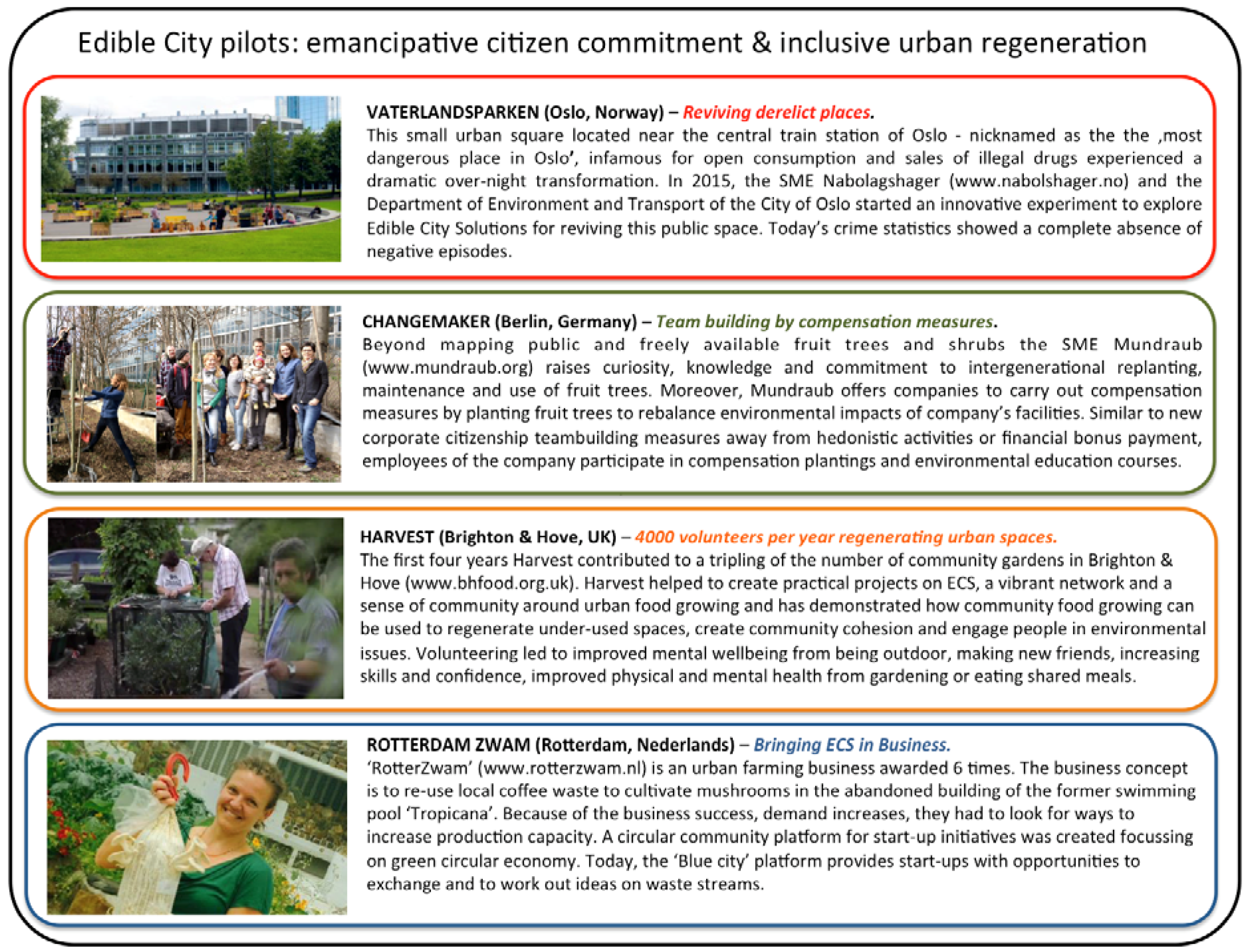
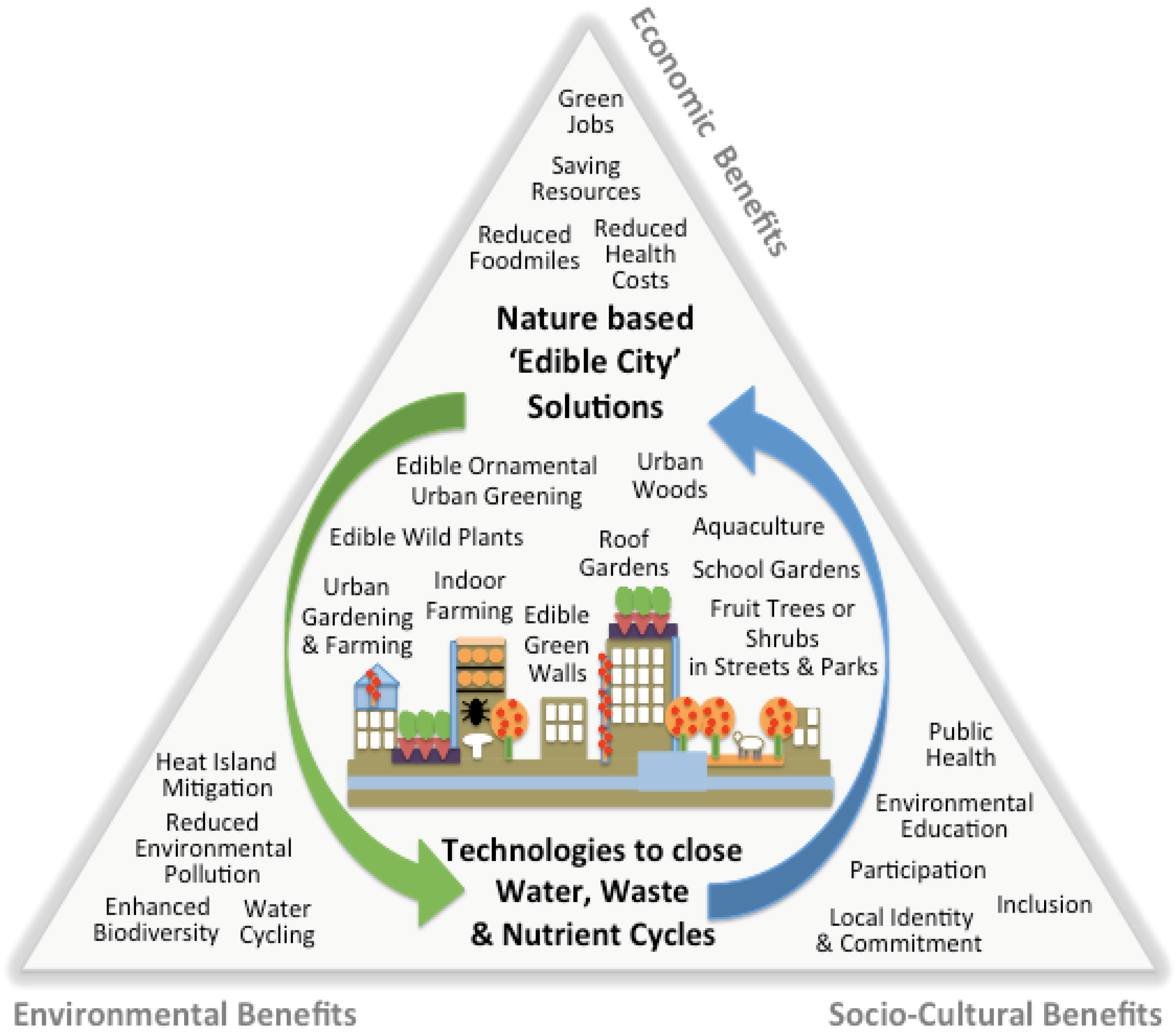
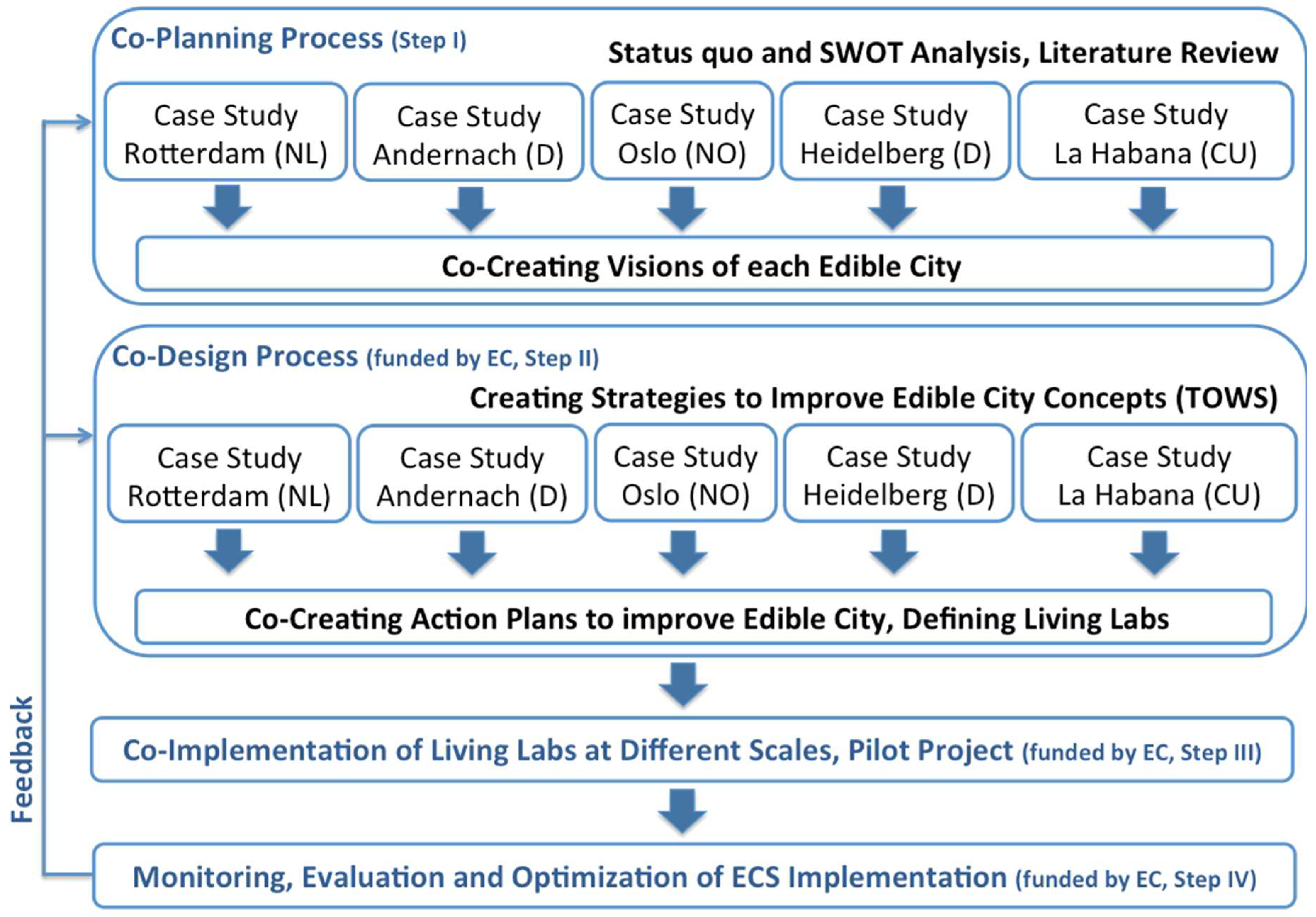
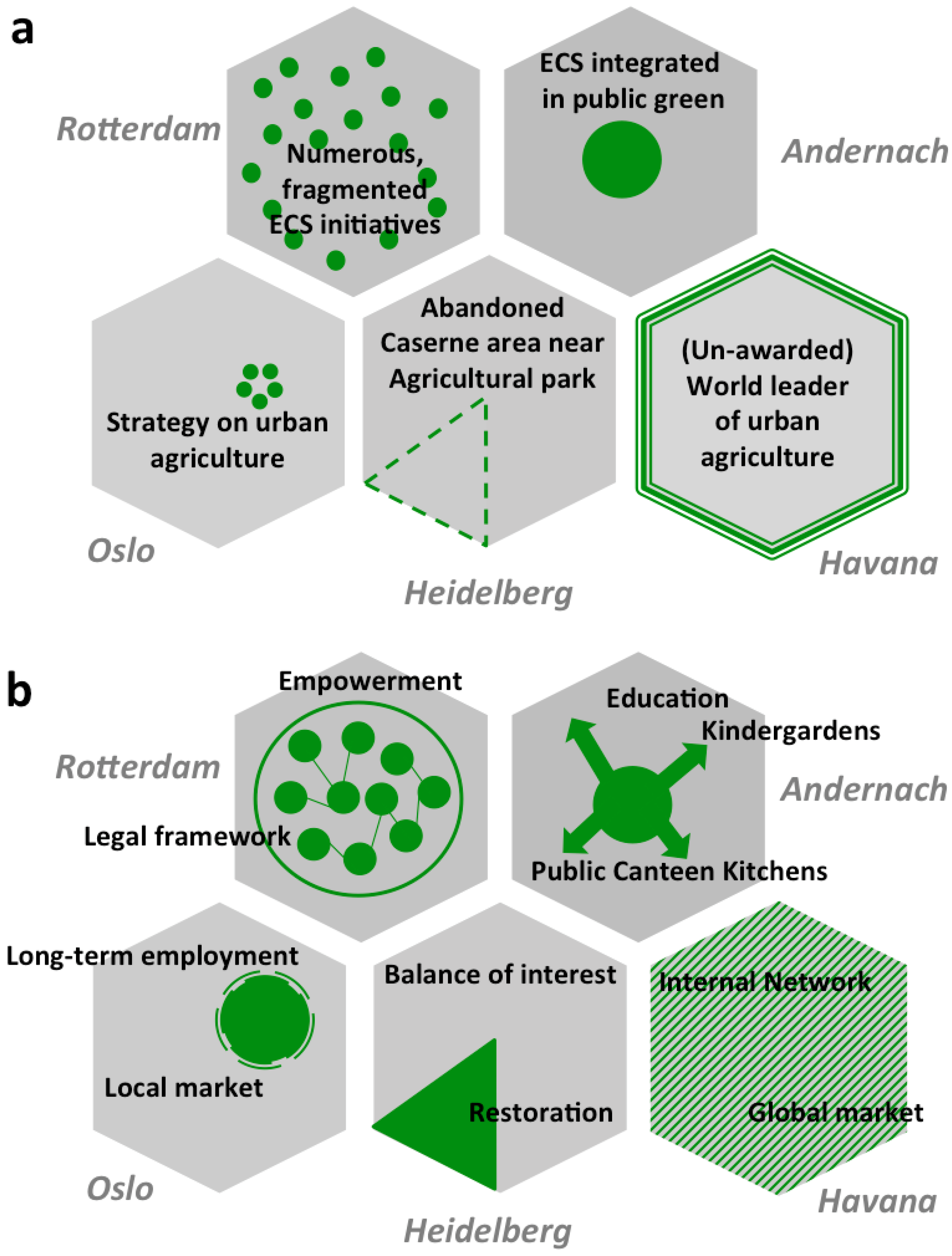
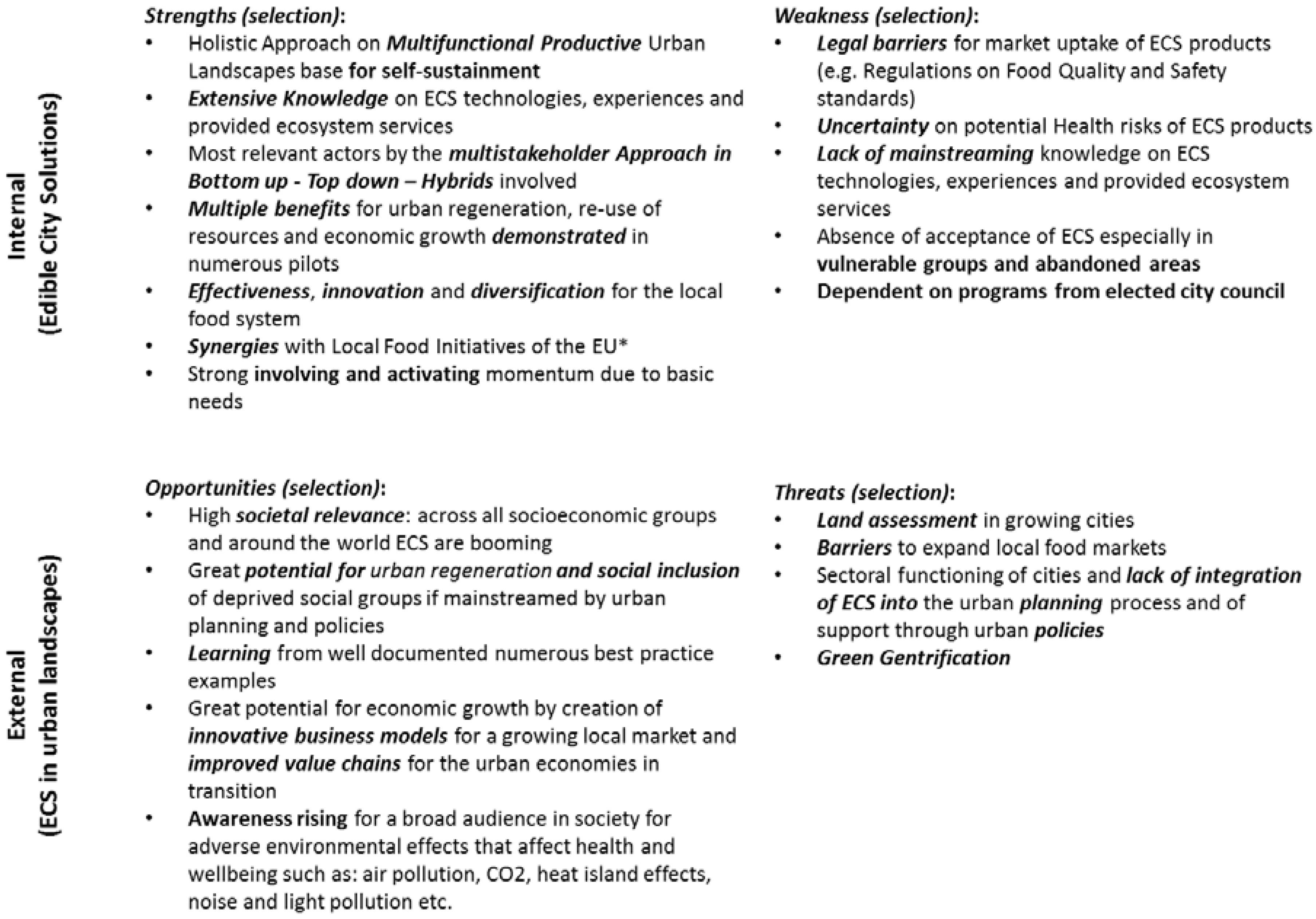
| Case Studies | Rotterdam | Andernach | Oslo | Heidelberg | Havana |
|---|---|---|---|---|---|
| ECS | Over 200 small grass root initiatives, not associated are most vulnerable to changes | Integration in municipal green spaces | Municipal grant for 2017 for center of urban ecological innovation with 184,000€ | Several initiatives from production of ancient grains, local food markets to bee keeper association | Agricultural Area 35 900 ha (2014), >90,000 residents involved, Productivity yield of 20kg/m2 |
| Governance and policy | Integrated in elected City council with their program, top down, program: “Food & the City” (Gemeente Rotterdam 2012) | Integrated in municipal compulsory tasks, top down, to expand | Municipal Master plan revised all 4 years, adoption of co-designed urban agriculture strategy in 2017, bottom-up | City council (elected all 5 years) initiated IBA (first bottom-up IBA), sustainability programs | National programs for urban and peri-urban food production; Protection of agricultural areas above construction |
| Decision makers and their Objectives | City council, officials of boroughs, executive committee (major), anchoring main responsibility and simplicity of relations to City council | City council/ “Perspektive gGmbH” Integration of high-quality food supply in municipal compulsory tasks, | City council, City government and elected district councils, establishment of a center of urban ecological innovation (founded 2016) for green transformation | Mayor and City council, ecological committee, Dep. Building and Traffic/Environment, Sustainable food, livable Neighborhoods | Broad support of different levels of city administration to grant vacant land, Enhancing of participation of vulnerable groups Technical Advisory board for a wide network incl. research institute |
| Barriers | Widely scattered responsibility in different departments, no legal adaption to urban agriculture | Availability of areas and spaces, access to private space, need of optimized procedure in the municipality | Considered as spare time activity not as profession with full-time jobs, legal barriers regarding selling rights for urban agriculture food | Conflict of interest to use specific green areas, regulative barriers on food, contracting and renting schemes renegotiate | Organization of urban food producers, Management of infrastructure and ECS Technologies Isolation of Cuba from the global ECS market |
| Awards | C 40 Cities Adaptation Planning & Assessment 2015; Sustainable Architecture 2011Greenest Port 2016 | Most Livable City 2013; Land of Ideas 2013 | European Sustainable City 2003; European Green Capital 2019 | European Sustainable City 1997, 2003; Global Green City 2015; Fair Trade Town 2010 | (Un-awarded) World leader of urban agriculture |
| Specific Challenges | Integration, employment and education in socio-cultural diverse society Overcoming fragmentation and financial instability, fragile availability of expertise and experience of high potential ECS grass root movements | Beneficial social networks across the entire city population; Access to healthy and fresh food for vulnerable groups: refugees and marked by life children | Regeneration of neglected areas and counteract gentrification processes; Inclusion of immigrants with special focus on: women, single parents and high school dropouts | Restoration of abandoned areas and tensed housing market; Social pressure and conflicts of interest in relation to open space use | Preservation of long-term self-sufficient urban food production and optimization towards user-friendly large-scale ECS and fostering local entrepreneurship; Connection of Cuban ECS technologies and knowledge on organic agriculture to the global ECS market and |
| Socio-Ergonomic Factors | Socio-Cognitive Factors | Socio-Economic Factors |
|---|---|---|
| Reachability and connectivity within the urban matrix: Reduce distance from users to ECS and between ECS, enhance walkability and connectivity Accessibility: Allow open participation and barrier-free access Usability: Foster user-friendly processes and design, manageability of ECS | Lateral hierarchies: Power and knowledge distribution in communities to minimize inequalities) Perception and acceptance: Advantages of involvement by multi-stakeholder approaches | Mutual impact on social processes and economics: Foster economic activity affects social life and return Fostering entrepreneurship Support novel and innovative and self-sustaining market uptake of ECS techniques and ECS technologies |
© 2019 by the authors. Licensee MDPI, Basel, Switzerland. This article is an open access article distributed under the terms and conditions of the Creative Commons Attribution (CC BY) license (http://creativecommons.org/licenses/by/4.0/).
Share and Cite
Säumel, I.; Reddy, S.E.; Wachtel, T. Edible City Solutions—One Step Further to Foster Social Resilience through Enhanced Socio-Cultural Ecosystem Services in Cities. Sustainability 2019, 11, 972. https://doi.org/10.3390/su11040972
Säumel I, Reddy SE, Wachtel T. Edible City Solutions—One Step Further to Foster Social Resilience through Enhanced Socio-Cultural Ecosystem Services in Cities. Sustainability. 2019; 11(4):972. https://doi.org/10.3390/su11040972
Chicago/Turabian StyleSäumel, Ina, Suhana E. Reddy, and Thomas Wachtel. 2019. "Edible City Solutions—One Step Further to Foster Social Resilience through Enhanced Socio-Cultural Ecosystem Services in Cities" Sustainability 11, no. 4: 972. https://doi.org/10.3390/su11040972
APA StyleSäumel, I., Reddy, S. E., & Wachtel, T. (2019). Edible City Solutions—One Step Further to Foster Social Resilience through Enhanced Socio-Cultural Ecosystem Services in Cities. Sustainability, 11(4), 972. https://doi.org/10.3390/su11040972





